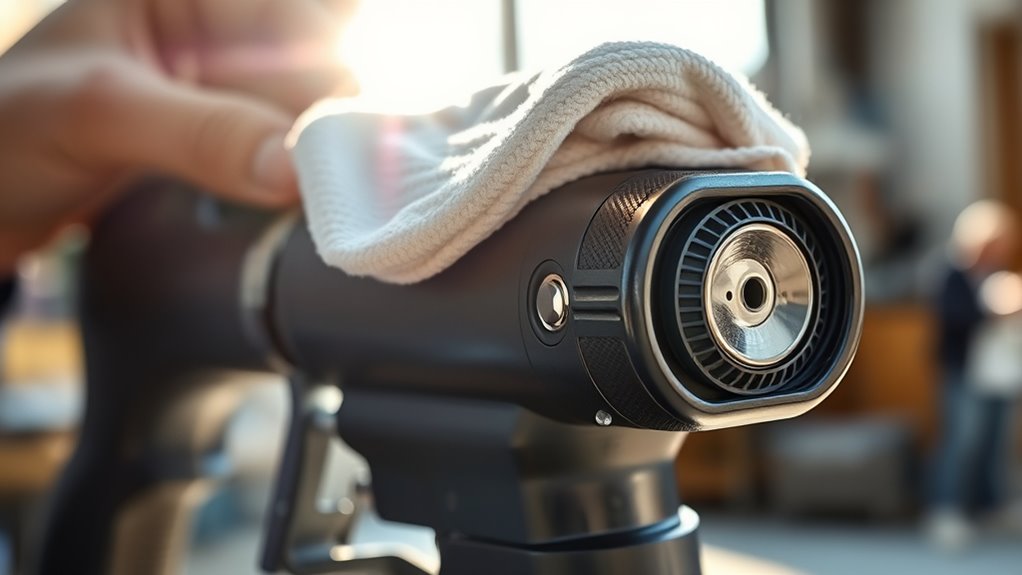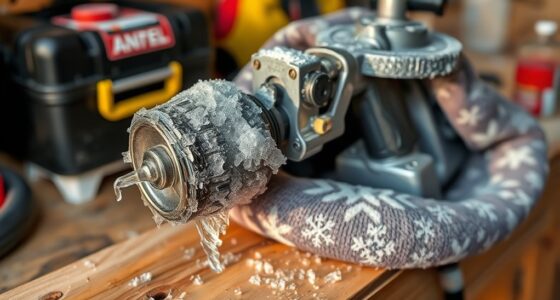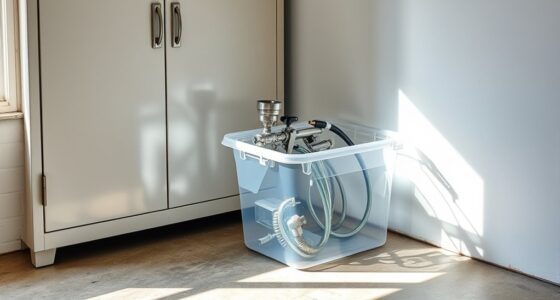To maintain your battery-powered paint sprayer, regularly check and clean the battery contacts using a soft cloth or brush to guarantee good electrical connection. Avoid frequent deep discharges by waiting until the battery is low before recharging, and try partial charges between 20-80% to extend lifespan. Store batteries in a cool, dry place, ideally around 20°C, and remove and partially charge them if storing long-term. Continuing this guide will help you keep your sprayer in top shape.
Key Takeaways
- Regularly clean battery contacts with a soft cloth to ensure reliable electrical connection.
- Store batteries in a cool, dry place at around 20°C (68°F) to prevent capacity loss.
- Avoid overcharging by unplugging the battery once fully charged, reducing unnecessary charging cycles.
- Keep batteries in partial charge (50-60%) if storing long-term to prevent deep discharge or overcharging.
- Understand your battery chemistry to follow proper care practices that maximize lifespan and performance.

Have you ever struggled with tangled cords or limited movement while painting? If you’re using a battery-powered paint sprayer, you know how freeing it can be to cut the cord and move freely around your workspace. But to keep your sprayer performing at its best, you need to care for its battery properly. One key aspect is understanding the importance of managing charging cycles. Every time you recharge your battery, you complete a charging cycle, and batteries have a limited number of these before their capacity diminishes. To maximize the lifespan of your battery, avoid unnecessary charges—wait until the battery is truly low before recharging. Partial charges, about 20-80%, are better than full ones, as they reduce strain on the battery and extend its overall life. Keeping track of your charging habits helps prevent premature decline in power, guaranteeing your sprayer remains reliable when you need it most. Additionally, staying informed about battery chemistry and its effects can help you make smarter decisions for longevity.
In addition to managing charging cycles, paying attention to storage temperatures plays a vital role in maintaining your battery’s health. Batteries perform best when stored in cool, dry environments. Excessive heat accelerates chemical reactions inside the battery, leading to capacity loss over time, while extreme cold can temporarily reduce performance. Ideally, store your battery at room temperature—around 20°C or 68°F—and avoid leaving it in direct sunlight or in freezing conditions for prolonged periods. If you’re not planning to use your sprayer for a while, remove the battery and store it separately, guaranteeing it’s partially charged—around 50-60%—to prevent deep discharge or overcharging during storage. Taking these precautions helps preserve the battery’s capacity and prolongs its lifespan, saving you money and frustration down the line.
Regular cleaning of your battery contacts also contributes to peak performance. Dirt, dust, or corrosion can interfere with the flow of electricity, causing inconsistent power delivery or even damage to the contacts. Use a soft cloth or a brush to gently clean the terminals and connectors after each use, and make sure they’re dry before reattaching or storing the battery. Additionally, avoid exposing your battery to water or moisture, as this can cause internal damage and reduce its lifespan. By integrating these simple maintenance steps—mindful charging habits, proper storage temperatures, and clean contacts—you guarantee your battery-powered paint sprayer stays reliable and efficient. This way, you’ll enjoy smoother operation, fewer interruptions, and longer-lasting performance, making your painting projects more enjoyable and less stressful.
Frequently Asked Questions
How Often Should I Replace the Battery in My Paint Sprayer?
You should replace the battery in your paint sprayer when you notice a significant drop in performance or it no longer holds a charge. Typically, battery lifespan and replacement frequency depend on usage and care, but most batteries last about 2-3 years. Keep an eye on how well your sprayer performs over time, and replace the battery when it can’t deliver the power needed for your projects efficiently.
Can I Store the Battery in Extreme Temperatures?
Storing your battery in a less-than-ideal environment can quietly diminish its lifespan. You should avoid exposing it to extreme temperatures, as high or low battery temperature can damage the internal components. Instead, keep your battery in a cool, dry storage environment, away from direct sunlight or freezing conditions. Proper storage protects its health, ensuring your paint sprayer remains ready when you need it most.
Is It Safe to Leave the Battery on Charge Overnight?
Leaving the battery on charge overnight isn’t generally safe, as it can lead to overcharging and potential damage. Focus on proper battery charging by unplugging once it’s fully charged to guarantee overnight safety. You avoid risks like overheating or reduced battery lifespan. Always follow the manufacturer’s instructions for charging times and procedures, and use the correct charger to keep your battery safe and in good condition.
What Are Signs That My Battery Needs Professional Servicing?
If your battery shows signs like decreased runtime, inconsistent charging, or abnormal charging indicators, it’s time for professional servicing. These issues can affect your battery’s lifespan and performance. Don’t ignore warning signs, as they may indicate internal damage or deterioration. Regularly monitor charging indicators and note any irregularities. When in doubt, consult a professional to guarantee your battery stays in peak condition and prolongs its lifespan.
How Do I Properly Dispose of Old or Damaged Batteries?
Thinking of tossing that old battery? Don’t be that person! Instead, you should prioritize proper disposal by taking it to a battery recycling center. Remember, batteries are hazardous waste—think of them as tiny ticking time bombs for the environment. Proper battery recycling guarantees harmful chemicals stay out of landfills and water sources. So, skip the trash, do the right thing, and protect our planet from unnecessary danger!
Conclusion
Keeping your battery-powered paint sprayer in top shape is simple with proper care. Regularly clean the battery contacts, store it in a cool, dry place, and recharge it properly to extend its lifespan. Remember, a well-maintained sprayer saves you time and money in the long run. Aren’t your projects worth the extra effort to keep your tools functioning like new? With these tips, you’ll enjoy smooth, efficient painting every time.
Franz came aboard the Paint Sprayer Zone team with a background in both journalism and home renovation. His articulate writing style, combined with a passion for DIY projects, makes him an invaluable asset. Franz has a knack for breaking down technical jargon into easy-to-understand content, ensuring that even the most novice of readers can grasp the complexities of paint sprayers.










